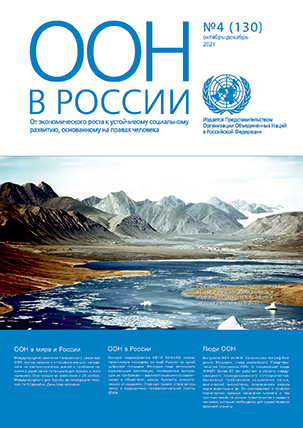FAO takes stock of food security and nutrition in Europe and Central Asia
FAO report for the region now available in Russian
2 April 2019 (FAO News) - In the Regional Overview of Food Security and Nutrition in Europe and Central Asia 2018, FAO experts flag their concerns with regards to the situation with food security and nutrition in the region of Europe and Central Asia. The work covers a wide range of issues: dietary energy supply, undernourishment and nutrition indicators, such as stunting and wasting, anaemia, overweight and obesity, and the effects of the shifts in people's diets.
Facts point to stagnation in the progress on food security and nutrition.
The Russian version of the publication, based on a detailed survey of monitoring trends, was officially launched today at an expert discussion in the United Nations House, Moscow.
The report makes an assessment of progress made by each country toward the Sustainable Development Goal 2 targeting Zero Hunger and improved nutrition by 2030. It also reviews policy measures and solutions that countries apply (or could apply) to address all four dimensions of food security – availability, access, utilization and stability – and nutrition. The report places special focus on the role of migration, rural women and youth in sustainable development.
The report reveals that more than 14 million adults, and some 4.7 million children in Europe and Central Asia suffer from severe food insecurity, as defined by the Food Insecurity Experience Scale (FIES). FAO estimates that some 2.1 percent of the region's total population of nearly one billion was exposed to severe food insecurity in 2015-2017 based on FIES data.
Although this indicator stands at around 2 percent here, which is far lower than the world average of 9.2 percent, the state of affairs in the countries with persisting hunger and malnutrition needs to be addressed as an urgent issue, FAO experts emphasize.
The launch of the Regional Overview was kick-started by a keynote presentation by Viorel Gutu, FAO Subregional Coordinator for Central Asia. The discussion was invigorated by ensuing reports by Sergei Kiselev, Head of Chair of Agroeconomics at Lomonosov Moscow State University; Irina Ivakhnyuk, Deputy Head of Chair of Demography at Lomonosov Moscow State University; Tatyana Nefedova, Lead Scholar at the Institute of Geography of the Russian Academy of Sciences; Jahan Kurbanova, economist; and Mauricio Rosales, coordinator of the Russian-funded FAO project on “Developing capacity for strengthening food security and nutrition in the Caucasus and Central Asia.”
Russian government officials, members of the Moscow-based diplomatic corps, academic institutions and media attended the discussion.
Malnutrition remains a problem
Since 2014, the decreasing trend on the prevalence of undernourishment has been stagnating at 6 percent while in 2016 and 2017 the number of undernourished people in Central Asia has been slowly growing in absolute terms.
Another key finding of the authors of the report is that malnutrition in one or more of its three main forms – undernutrition, overweight and obesity, and micronutrient deficiencies – is present to varying degrees in all countries of the region. Often all three forms coexist, creating what is called the “triple burden of malnutrition.”
Millions still suffer from micronutrient deficiencies – in particular anaemia, which occurs at significant levels in many countries, including in high-income countries. Anaemia in women of child-bearing age is on the rise, constituting an important public health problem.
A recent World Health Organization analysis showed a continuous increase in overweight among children and in the prevalence of obesity among adults across the Europe and Central Asia region in the period from 2000 to 2016. Some 200 million people (one quarter of adults) are now obese, which constitutes a major concern for their future health and well-being and related public health costs.
Migration, gender, youth and rural development
The report also establishes close linkages between migration, gender, youth and rural development and food security. Europe and Central Asia region ranks second in the world for receiving migrants: 78 million international migrants of the total 258 million worldwide in 2017.
Migration – whether within a country or across borders – can become a source of development opportunity. In recent years, remittances sent home by migrant workers have lifted millions of families out of poverty and food insecurity. Remittance flows within the region in 2017 were estimated at US$ 44 billion.
According to FAO experts, poverty in rural areas and food insecurity caused by low productivity and generally low level of agricultural development are on top of the list of reasons for labor migration to Russia from Central Asia and Azerbaijan. Equally important factors include inequality in the level and quality of life between urban and rural areas, internal and external conflicts leading to political instability, limited access to basic social services, and environmental problems.
In Russia, according to statistics, there are two and a half million labor migrants from Uzbekistan, half a million from Kazakhstan and the same number for Kyrgyzstan, 900 thousand from Turkmenistan and a similar figure for Azerbaijan. In 2017, the Russian Federation hosted more than 11 million international migrants, with half coming from neighboring countries.
Labour migration from Armenia, the Republic of Moldova, Ukraine and Central Asian countries to Russia and other countries (and, for the Central Asian countries, to Kazakhstan) forms one of the largest and most stable migration corridors in Eurasia and the world, FAO experts postulate.
The gender aspect of migration in also on the radar: women constitute 52 percent of international migrants in Europe and Central Asia, with important implications for social and family dynamics and for the vulnerability of children, the elderly, and disabled groups.
The report draws on country experiences to highlight measures aimed at mitigating negative consequences of migration on food security, and harnessing its development potential. These include support measures for migrants returning to their country of origin, and the potential of rural development to offer alternative livelihood options to involuntary migration.

